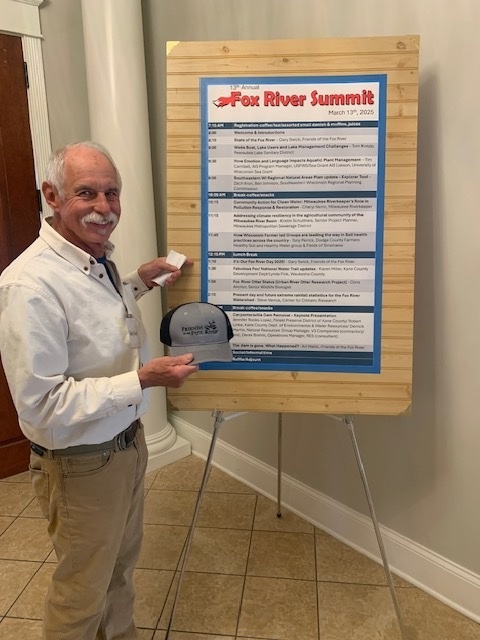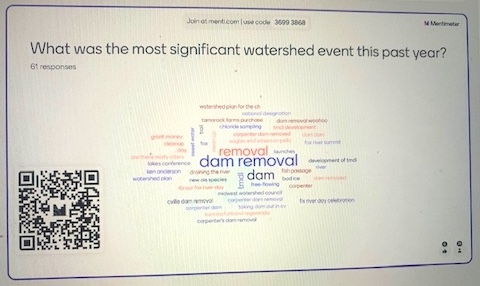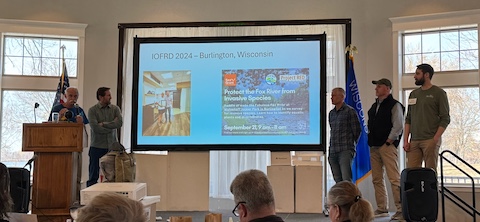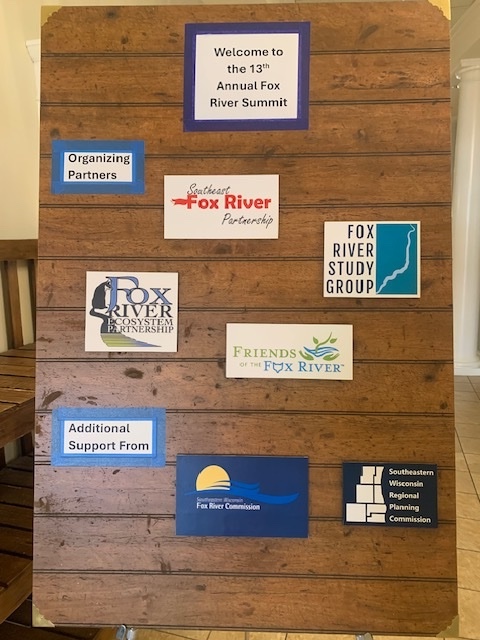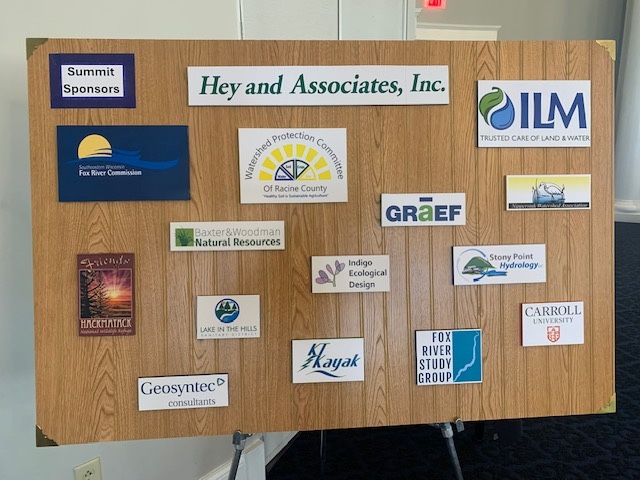Founder of Friends of the Fox River, Pat Reese, emphasized that protecting the Fox River would take a watershed approach. This implies addressing issues as a region undivided by municipal boundaries. The annual Fox River Summit is a major step in that direction. The collaborative effort to develop the bi-state Fabulous Fox Water Trail (FFWT) was born out of the Fox River Summit. Our own It’s Our Fox River Day (IOFRD) is also an example of a successful watershed-wide initiative.
We all live downstream and are connected.
A Watershed Moment
The Fox River Summit on March 13 in Burlington, Wisconsin was an annual gathering for sharing information and building partnerships to approach the issues important to the management of the watershed. The program featured speakers and presentations highlighting those issues and was an opportunity to celebrate success stories throughout the watershed. This year’s Summit kicked off with a land acknowledgement to honor Indigenous people, the watershed’s stewards for centuries before European settlement.
2024 Achievements
The first presentation was an updated version of the State of the Fox, which I presented at Schweitzer Environmental Center in January, with a top ten list. Noteworthy achievements were profiled, and a few concerns, like the growing presence of the Quagga mussels, harmful algal blooms (HAB), and H5N1 influenza (bird flu) were discussed. The audience was polled to share the most significant watershed event and worst issue. Dam removal (specifically the Carpenter Dam) and pollution/dams were the leaders, respectively. That poll was a good endorsement for the day’s keynote presentation, the Carpenter Dam Removal.
Conflict Resolution
The presentation, The Wake Boat, Lake Users, and Lake Management Challenges was a good example of the challenges of multiple use on a limited resource. The objectives of providing wake-producing recreation while also having a weed-free lake are not compatible. Deep propellers stir up sediment which distributes phosphorus, feeding undesirable weeds. In addition, some plants are cut or dislodged and then float to weedless areas. Lake management requires education, some restricted uses, and expensive and extensive plant harvesting.
The next presentation, Emotion and Language in Aquatic Invasive Species Management, addressed the psychology of working effectively with the public. The big takeaway for many of us was that we must align values with all constituents to build a foundation for conversations about conflicts over use perspectives. We all love our watershed but sometimes for incompatible reasons.
History Lessons & Uncertain Futures
The Milwaukee Riverkeepers provided a wonderful and well-established example of successfully managing the watershed for three rivers that encompass rural/agricultural, suburban, and urban land uses. Many components of their programs are practices that we could be applying full scale in our Fox River Watershed. The following presentation on Climate Resiliency offered the conditions of longer growing seasons that are warmer and wetter. The increase in farmland rentals was raised as a concern that will significantly impact food production in our watershed.
Fabulous Farmers
The summit is attended primarily by those who self-identify as natural resource specialists, along with agency staff, business representatives, municipal officials, organization members, educators, and individuals from the public sector. A minority group of agriculture experts (farmers) are regular favorites with the crowd. They represent 48 groups in Wisconsin that are transforming agricultural practices to build soil and protect water quality. They shared their strategy for field days, pasture walks, and pontoon boat rides, show-and-tell style demonstrations to each other and the public. This group always wows the audience with their dedication and positive results. They are changing their farming culture to adopt a sustainable path.
Crossing the State Line
The two watershed-wide components of the FFWT & IOFRD offered updates.
The FFWT will develop five new launches with solar-powered interactive informational screens at each location. This year, IOFRD celebrated a growing Wisconsin participation. The mayor and other representatives of Burlington, Wisconsin received a special recognition certificate for their exceptional participation which included a municipal proclamation of IOFRD, the first ever launch party at Low Daily Brewery, an aquatic invasive plant training/survey, and park cleanups at 17 different locations. A challenge was offered to sign up right there and then to host a IOFRD ’25 event. 13 members of the audience answered that challenge.
Otters & Wacky Weather
We love our wildlife, and the presentation on otters was a treat. Validation that otters are thriving in Spring, Flint and Poplar Creeks was established. The natural history of these fun-loving mammals was shared along with how their whiskers can be analyzed to document their varied dietary habits.

The joy-producing otter presentation was followed by some harsh reality with the Present Day and Future Extreme Rainfall Statistics for the Fox River Watershed presentation. The data clearly depicted increases in extreme weather events like Wisconsin’s first February tornado. Last summer, we saw that we can go from record rainfall to drought conditions in two months. Trends indicate an increase in both precipitation and temperature. Basically, the water cycle is increasing in strength. Evaporation, precipitation, and transpiration all increase into a warmer atmosphere which can hold more moisture. The analogy of a bigger sponge made sense to me. Seasonally, this information has different implications on soil runoff. More rain and less snow leads to winter runoff events. As usual, changes in nature are complicated.
Hottest Topic

The Removal of the Carpenter Dam group presentation was the Summit finale. The Kane County Forest Preserve District, who owned the dam, explained the process. The hired V3 group developed the plan and performed deconstruction. Kane County was representing the other 3 regulating agencies with additional comments. Friends of the Fox River’s (FOTFR) board member, Art Malm wrapped up the presentation with his photo essay of the process.
Deeper Dive
This was the 14th Fox River Summit. Several presentations were not included in this article. All can be viewed here. This summit followed over 160 previous presentations, You can view most of the diverse and interesting topics from past summits here.
Mark your calendar for attending next year’s Fox River Summit. You will not be disappointed. Everyone goes home with some swag, having learned much and inspired to do more.


